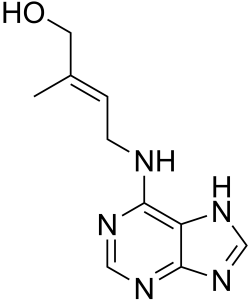Role of Cytokinins in Plants
Cytokinin is an important plant growth regulator which causes cell divisions
Discovery:
- G. Haberladt (1913) discovered an unknown compound from the vascular tissues which causes rapid cell division, cork cambium formation and wound healing.
- Miller (1955) isolated a substance from Yeast DNA which causes cytokinesis (division of cytoplasm). He called it kinetin.
- Letham (1963) isolated a crystal from the immature corn grain. He called it zeatin. Later on a number of substances have been discovered which are responsible for cytokinesis. Therefore, the term cytokinin is still used for all of them.
- Cytokinesis is also known as coconut milk factor, because it has been observed from the endosperm of coconut.
- Bioassay of Cytokinin: The most rapid and sensitive bioassay of cytokinin is Betacyanin synthesis test.
Definition:
Skoog (1964) and Mothes (1967) defined cytokinin as a ‘generic name for substances which promote cell division and causes other growth regulatory functions in the same manner as zeatin’.
Horgan (1984) defined ‘substance which in the presence of optimal auxin causes cell division in tobacco and other similar assay system grown on an optimally defined medium’.
Distribution: Cytokinins are mostly found in meristematic cells of angiosperms and Conifers. They are also present in mosses, red algae, brown algae, diatoms, phytopathogenic bacteria and fungi. They are also obtained from t-RNA, r-RNA and DNA.
Translocation: it occurs through xylem in all parts. Phloem is also more effective.
Structure: All the cytokinins have purine (adenine) rings with a side chain rich in C and H.

Types of Cytokinins:
Natural cytokinins:
1. Zeatin
2. IPA (Isopentenyl amino purine)
Synthetic cytokinins:
1. Kinetin
2. 6-Benzyl aminopurine.
Biosynthesis: The exact mechanism of the biosynthesis of cytokinin is not well known. But a breakthrough came after the work of Chung-Mmaw-Chen and D.K. Melitz (1979) that tobacco tissues contain an enzyme that forms Isopentenyl adenosine 5-phosphate which gives cytokinin.
Role (Function or Significance) of Cytokinins:
1. Cell division: It is the most striking or peculiar feature of cytokinin. Cytokinin causes cell division in the presence of sufficient amount of auxin which would otherwise not divide when IAA and kinetin are applied together (2 ppm IAA and 0.02 ppm kinetin). The callus growth can be maintained indefinitely. IAA involves in DNA replication while kinetin in cytokinesis.
2. Cell enlargement: Like IAA and GA3, cytokinin also causes increase in size of leaf and cotyledonary tissue. According to Arora (1959) cytokinin causes enlargement of cortical cells of tobacco root upto four times of their normal size.
3. Morphogenesis (Callus formation): Cytokinin causes the morphogenetic change in tissue culture. In callus, root and shoot initiation can be induced by varying ratio of IAA and kinetin. If kinetin-IAA ratio is high, shoot formation is initiated and if low, root formation is initiated. Some other morphogenetic responses are formation of plastids from pro-plastids, differentiation of tracheids and induction of flowering and parthenogenesis.
4. Formation of parthenocarpic fruit: It is a characteristic feature of cytokinin. e.g., Ficus carica (anjir), Vitis vinifera (grapes) etc.
5. Dormancy: Cytokinins break dormancy.
6. Flowering: Cytokinins induce the flowering in short day plants under long day condition.
7. Reversal of apical dominance: In some plants cytokinins can reverse the effect of apical dominance.
8. Delay of senescence (Delayed ageing): Cytokinins as compared to gibberellins are more effective in delaying senescence in aerial parts of plants by controlling protein synthesis and mobilization of resources. If cytokinins are added in droplets to the yellowing of part of leaf blade, the treated areas become green and fresh.
9. creasing in fruit size: A preparation called promalin (a mixture of CK i.e., 6-benzyl adenine, GA4 and GA5 seems to be very active in stimulating the size of apple fruit particularly in red delicious apple.
10. Breakdown: Cytokinins prevent the breakdown of protein, nucleic acid and chlorophyll.
Mechanism of Action of Cytokinin:
The exact mechanism of action of cytokinin is not fully understood. Some cytokinins occur as constituents of t-RNA. They determine the confirmation of anticodon. It is just possible that cytokinins influence growth through two forms: one incorporated inside of t-RNA and the other in free-state. The t-RNA contained cytokinins control the synthesis of proteins and hence enzymes. The free cytokinins may protect such t-RNA from ribonucleases or actually help in the synthesis of new t-RNA .
